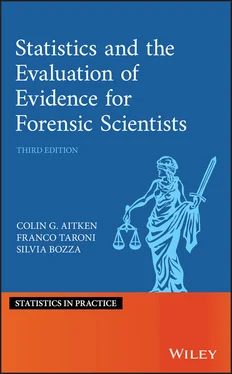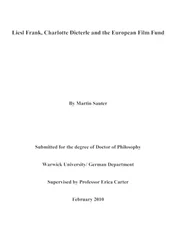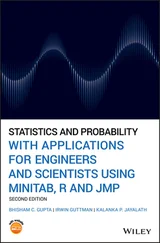Franco Taroni - Statistics and the Evaluation of Evidence for Forensic Scientists
Здесь есть возможность читать онлайн «Franco Taroni - Statistics and the Evaluation of Evidence for Forensic Scientists» — ознакомительный отрывок электронной книги совершенно бесплатно, а после прочтения отрывка купить полную версию. В некоторых случаях можно слушать аудио, скачать через торрент в формате fb2 и присутствует краткое содержание. Жанр: unrecognised, на английском языке. Описание произведения, (предисловие) а так же отзывы посетителей доступны на портале библиотеки ЛибКат.
- Название:Statistics and the Evaluation of Evidence for Forensic Scientists
- Автор:
- Жанр:
- Год:неизвестен
- ISBN:нет данных
- Рейтинг книги:3 / 5. Голосов: 1
-
Избранное:Добавить в избранное
- Отзывы:
-
Ваша оценка:
Statistics and the Evaluation of Evidence for Forensic Scientists: краткое содержание, описание и аннотация
Предлагаем к чтению аннотацию, описание, краткое содержание или предисловие (зависит от того, что написал сам автор книги «Statistics and the Evaluation of Evidence for Forensic Scientists»). Если вы не нашли необходимую информацию о книге — напишите в комментариях, мы постараемся отыскать её.
he leading resource in the statistical evaluation and interpretation of forensic evidence
The third edition of
is fully updated to provide the latest research and developments in the use of statistical techniques to evaluate and interpret evidence. Courts are increasingly aware of the importance of proper evidence assessment when there is an element of uncertainty. Because of the increasing availability of data, the role of statistical and probabilistic reasoning is gaining a higher profile in criminal cases. That’s why lawyers, forensic scientists, graduate students, and researchers will find this book an essential resource, one which explores how forensic evidence can be evaluated and interpreted statistically. It’s written as an accessible source of information for all those with an interest in the evaluation and interpretation of forensic scientific evidence.
Discusses the entire chain of reasoning–from evidence pre-assessment to court presentation; Includes material for the understanding of evidence interpretation for single and multiple trace evidence; Provides real examples and data for improved understanding. Since the first edition of this book was published in 1995, this respected series has remained a leading resource in the statistical evaluation of forensic evidence. It shares knowledge from authors in the fields of statistics and forensic science who are international experts in the area of evidence evaluation and interpretation. This book helps people to deal with uncertainty related to scientific evidence and propositions. It introduces a method of reasoning that shows how to update beliefs coherently and to act rationally. In this edition, readers can find new information on the topics of elicitation, subjective probabilities, decision analysis, and cognitive bias, all discussed in a Bayesian framework.


 has been omitted.
has been omitted. and
and  are such that, given background information
are such that, given background information  ,
,
 is independent of the knowledge of
is independent of the knowledge of  . From ( 1.9) it can be seen that
. From ( 1.9) it can be seen that
 and
and  say. The outcome of the throw of
say. The outcome of the throw of  does not affect the outcome of the throw of
does not affect the outcome of the throw of  . If
. If  lands 6 uppermost, this result does not alter the probability that
lands 6 uppermost, this result does not alter the probability that  will land 6 uppermost. The same argument applies if one die is rolled two or more times. Outcomes of earlier throws do not affect the outcomes of later throws. Similarly, with the drawing of two cards from a pack of 52 cards, if the first card drawn is replaced in the pack, and the pack shuffled, before the second draw, the outcomes of the two draws are independent. The probability of drawing two aces is 4/52
will land 6 uppermost. The same argument applies if one die is rolled two or more times. Outcomes of earlier throws do not affect the outcomes of later throws. Similarly, with the drawing of two cards from a pack of 52 cards, if the first card drawn is replaced in the pack, and the pack shuffled, before the second draw, the outcomes of the two draws are independent. The probability of drawing two aces is 4/52  4/52. This can be compared with the probability 4/52
4/52. This can be compared with the probability 4/52  3/51 if the first card drawn was not replaced.
3/51 if the first card drawn was not replaced. and
and  independent, and conditional on
independent, and conditional on  is
is
 appears as a conditioning event in all the probability expressions. The laws are the same as before but with this simple extension.
appears as a conditioning event in all the probability expressions. The laws are the same as before but with this simple extension.
 it can be said that DVI and DAI are not independent.
it can be said that DVI and DAI are not independent. and
and  , with
, with  . This gives rise to three genotypes that, assuming Hardy–Weinberg equilibrium to hold, are expected to have the following probabilities
. This gives rise to three genotypes that, assuming Hardy–Weinberg equilibrium to hold, are expected to have the following probabilities was contributed by the mother and allele
was contributed by the mother and allele  by the father, and vice versa . Both of these cases have probability
by the father, and vice versa . Both of these cases have probability  because of the assumption of independence (see Table 1.4). Note that
because of the assumption of independence (see Table 1.4). Note that  The particular locus under consideration is said to be in Hardy–Weinberg equilibrium when the two parental alleles are considered as independent.
The particular locus under consideration is said to be in Hardy–Weinberg equilibrium when the two parental alleles are considered as independent.










